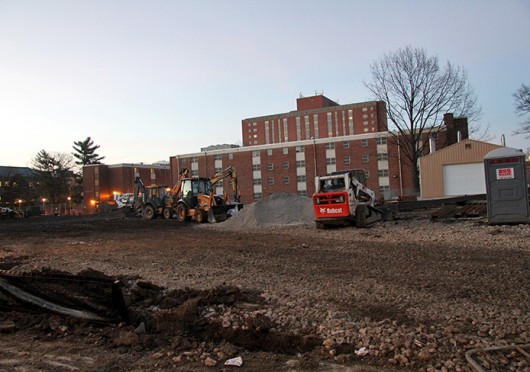
Construction vehicles sit outside of Scott House, located at 146 W. Woodruff Ave. Scott House is set to be demolished the first week of February.
Credit: Shelby Lum / Photo editor
Though the first demolition of the North Residential District Transformation is complete, some involved with the project said plans for the rest of the semester have not been finalized.
The transformation is “proceeding as planned,” said OSU spokeswoman for Administration and Planning Alison Hinkle in an email Jan. 22, but North Campus access road Curl Drive is set to remain permanently closed.
Curl Drive, which connects Neil and Woodruff avenues, closed in October, but accommodations for limited access were made for Thanksgiving break and winter break.
The road closure was part of the $370 million North Residential District Transformation, a renovation aimed at making OSU’s plan to have all second-years live on campus by Fall Semester 2016 possible by adding 3,200 additional beds through the construction of 11 new buildings. The project is scheduled for completion in fall 2016.
While OSU allowed temporary access to Curl Drive for students’ departures after closing it in 2013, Hinkle said Curl Drive will not re-open for spring break, which is March 10 through 14. She said OSU is working on an alternate plan to meet students’ accessibility needs.
“A system will (be) in place for spring break and details will be communicated to students and parents by the end of February,” Hinkle said.
She added that university officials are studying traffic patterns and past break accessibility plans to come up with the best possible plan for spring break.
“The removal of Curl Drive will enable the university to provide increased activity space and a more pedestrian-friendly environment,” Hinkle said. “That being said, maintaining access to the area during construction is a priority and we understand there are a variety of needs.”
Olivia Bobb, a first-year in pre-nursing and a resident of Drackett Tower, said she wants a spring break access plan that will minimize traffic and accommodate the greater need for parking.
“A plan I’d like to see for spring break would probably be less traffic,” Bobb said. “A lot of people get stuck and it’s just a huge traffic jam.”
Other students agreed congestion would be a problem when a large number of people are trying to leave campus at once.
“People can still get in but it’s difficult for a large amount of people to get out at once, for all the parents that are here,” said Dylan Kreitzer, a first-year in business and resident of Taylor Tower. “I mean, I usually leave a little bit later or a little bit earlier than other people so my parents don’t have a problem. But there’s a ton of people with the rush. It’s difficult to get everyone out at once.”
First-year student in biomedical engineering Jesse Keckler called the closure a “pain.”
“Having only that entrance open is just going to be really annoying. We’re going to get home but it’s going to be a little more annoying than it was before,” said the Taylor Tower resident.
The first of four vacant townhouses on Lane Avenue scheduled for demolition as part of the North Residential District Transformation was torn down Monday morning. Hinkle said the next buildings set to be demolished include Scott House this week and Raney Commons in mid-February.
Liz Gordon-Canlas, residence hall director of Drackett Tower and former resident of the townhouse demolished Monday, said the four houses used to be home to hall directors and other faculty and staff members.
“Seeing the house torn down is certainly a little bittersweet,” Gordon-Canlas said. “Knowing that they’re going to be replaced with some really wonderful facilities for our students in the coming years is a great feeling, but that was the very first place I lived with my husband, so it’s definitely a little sad to see it go. It had a lot of character.”
Andrew Todd-Smith contributed to this article.


